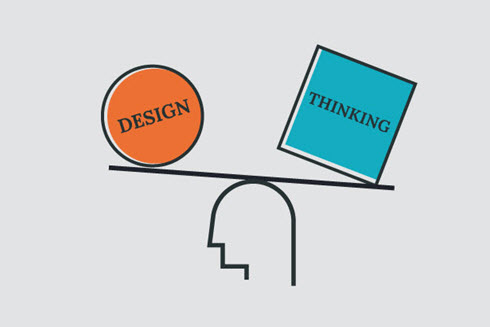Engineers are trained to effectively design and build infrastructure to meet safety and other regulatory requirements.
But what about designing infrastructure to make users, like pedestrians and cyclists, actually feel safe?
Or how about making it fun for the users? If we asked ourselves how to delight the end users, how would our design process look different?
Integrating empathy in problem-solving is at the core of the Design Thinking methodology. Design Thinking seems to have roots in some combination of engineering and industrial design. Undoubtedly, the design firm IDEO has brought the most attention to the methodology as a tool and has cultivated that toolbox since their founding in 1978.
Any engineer can meet a spec.
A designer can delight the end user.
Among the leaders in Design Thinking is Seth Godin, a bestselling author with a background in mechanical engineering. I recently spoke one-on-one with Godin about the importance of Design Thinking in business.
“Who’s it for and what’s it for? That is the essence of Design Thinking,” Godin said. “Who am I seeking to change? What change am I trying to make?”
In this series, we will be exploring the application of Design Thinking in a variety of settings looking at specific projects, including one from IDEO. I will also be sharing exercises intended to kick off various steps of the Design Thinking process that you can practice with your own team.

Skills not talents
Delving into empathy, soft skills, or basically anything related to psychology makes many engineers uncomfortable. The thinking of many is something like, “If I can’t put it in a spreadsheet or process it using a numerical model, it’s not something I will be good at.” After all, we are talking about emotions. It is common thinking to believe we cannot improve in these soft, emotional areas; we have an allotment at birth and that is it.
But what is the difference between talent and skill? A talent is something we have a natural aptitude for. Something like calculus is a skill. We take a course on it and we can see, concretely, the skills developing. We attend lectures, we do our homework, and then we see ourselves getting better.
Can you become more honest? How about more brave? More engaging? More empathetic?
If you can get better, but need to invest in effort, it is a choice – a choice you can make to develop a skill.
“Our choices lead to skill,” Godin told me. “Professionals do empathy on purpose.”
What does Godin mean here? He says it doesn’t take tremendous effort to have empathy for people we like and who are similar to us. So empathy does not mean that you like the other person.
“When you like someone else, you don’t need that much empathy,” Godin said. “Empathy means that when the outcome is important enough to you, that you are willing to exercise effort to get that outcome.”
Embrace the concept of “sonder”
Consider the concept Godin calls “sonder.” You are aware that you have many noises in your head: many cares, worries, values, hopes and dreams. Godin says “sonder” is the notion of realizing that every human around you has this same activity, this same level of complexity in their life and thinking.
Other people, whom we seek to serve as engineers, have thoughts, frustrations and beliefs that we can never fully know or understand. Empathy means that we care enough about the outcome to explore their point of view, and, in this case, to do our best to implement those cares and needs into our designs.
Our outcome could be an intersection designed to meet minimum safety and traffic light standards. Or our outcome could be an intersection that encompasses safety standards, feels safe for young women to use at night, and is fun for families crossing the street. Which would you rather use?
It’s clear already that developing empathy and asking the right questions are critical steps. Indeed, when we look at a typical outline of steps for solving a problem using Design Thinking, we find these at the very beginning.
As you take a look at the example exercise for empathy mapping, remember that what we’re doing is trying to come up with the solutions we cannot already easily see. We are aiming to immerse ourselves in the lives and mind’s eye of potential end-users.

Particularly when working on a team, it’s important to hold space for everyone to feel comfortable to share their ideas freely, without fear of being shamed. It’s a good idea to have team members agree to being open before they enter the process with their teammates.
“Certain problems are solved well with a spreadsheet,” Godin says. “Most are not. Most are doing things we don’t feel like, that we’re afraid of … things that might not work, but are important. Those are the things that separate technocrats from those who are actually going to change things.”
Empathy Mapping Exercise – Understanding the User/Client
Time Allotment: less than 45 minutes (Timing is not strict; however, time constraints can cultivate more expedited idea sharing, so consider using hard stops for steps 2, 3, and 4)
Tools Needed: Timer, sticky notes, paper/whiteboard and pen/markers
Overview: This exercise helps the participants draw out insights about their intended user or client based on a simple questioning and mapping technique.
Directions
This exercise is ideal for a group of 3-5 team members. Begin by identifying your target end-user or client. Several examples: pedestrians who are going to use the walkway and bridge of your design; colleagues who will have to use the workflow you set up in a piece of software; the people who will use the building you design; or the operator who will use the treatment plant you are designing.
Step 1: (Setup: 5-10 minutes) On the paper/whiteboard, sketch your user in the center (stick figure or circle with a name are fine). Draw four lines radiating out from that center to create four quadrants (just like an X and Y axis with your user in the very center). Write in the following labels for the four quadrants:
Upper left: “Says”
Upper right: “Thinks”
Lower left: “Does”
Lower right: “Feels”
Step 2: (Suggested time once members know what they’re doing: 10 minutes) Individually, each participant in the group should then use their own set of sticky notes to write their observations – one observation per sticky – and place it in the appropriate quadrant.
The key here is to really put yourself in the shoes of the user. How do they feel about the project? Why?
Minor discussion is OK in this step, but the point is to get each participant to contribute all of their own ideas and observations.
If we continued with the “pedestrian” concept, here are examples of what observations might be for each quadrant:
Says: I want extra greenspace with the walkway being installed.
Thinks: This city has failed us before, making designs for cars instead of people. I wonder if this will actually be different. I want my kids to grow up with safe places to bike, walk and play.
Does: Drives their kids to school even though it’s nearby.
Feels: Fears walking alone in other parts of the city at night; hopes what is installed in this new space will be different.
Go for volume here; make sure all ideas make it onto the board!
Step 3: (5 minutes) Look for similar or related items in the quadrants. Group them closer to one another. Prompt the team members to imagine how these aspects of the user’s life affect how they feel.
Step 4: (15-plus minutes) Label items on the map that are either assumptions, questions for later inquiry, or concepts that require validation.
Group discussion questions:
What was interesting to you?
What’s your biggest insight?
What do we all agree on?
What surprised you?
What’s missing?
Where do we have weakness or a strong need to validate information?
~
To be honest, the first time I engaged in an exercise like this, I resisted. I thought it was too touchy-feely. I thought we should not be wasting time on ideas that seemed silly. Only after watching others open up to their own and their teammates’ ideas could I see how a seemingly silly exercise opened the floodgate of ideas.
Next month, we’ll look at a specific project that used Design Thinking, and we’ll have another exercise you can try.
 Melissa (Mel) Butcher is the Private Sector Group Midwest Region Lead at Carollo. She holds a B.S. and M.S. in civil engineering from South Florida University. Mel currently focuses on industrial water treatment, water risk and sustainability. In her free time, she facilitates a career support group for women in male-dominated fields called CollabSuite, and she produces and hosts The Empowering Women Podcast.
Melissa (Mel) Butcher is the Private Sector Group Midwest Region Lead at Carollo. She holds a B.S. and M.S. in civil engineering from South Florida University. Mel currently focuses on industrial water treatment, water risk and sustainability. In her free time, she facilitates a career support group for women in male-dominated fields called CollabSuite, and she produces and hosts The Empowering Women Podcast.
Learn more or get in touch at MelTheEngineer.com


